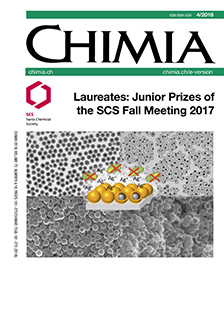High-spin Metal Centres in Dipolar EPR Spectroscopy
DOI:
https://doi.org/10.2533/chimia.2018.216Keywords:
Distance measurements, Epr spectroscopy, Gadolinium, Manganese, Motor proteinsAbstract
The substitution of Mg2+ by Mn2+ in the bacterial DnaB helicase from Helicobacter pylori, an ATP:Mg2+-fuelled protein engine, allows electron paramagnetic resonance (EPR) spectroscopy to be performed on this system. EPR experiments make it possible to monitor nucleotide binding and to estimate the fraction of bound Mn2+ through relaxation measurements. Furthermore, by measuring spin–spin distances we probe the geometry within such multimeric assemblies using ultra-wideband double electron-electron resonance (DEER) and relaxation induced dipolar modulation enhancement (RIDME). The extraction of distance distributions from RIDME experiments on high-spin paramagnetic centres is influenced by the presence of dipolar frequency overtones. We show herein that we can correct for these overtones by using a modified kernel function in Tikhonov regularization analysis routines, and that the overtone coefficients for Mn2+ in the DnaB helicase are practically the same as in the previously studied Mn2+–Mn2+ model compounds.Downloads
Published
2018-04-25
Issue
Section
Scientific Articles
License
Copyright (c) 2018 Swiss Chemical Society

This work is licensed under a Creative Commons Attribution-NonCommercial 4.0 International License.
How to Cite
[1]
Chimia 2018, 72, 216, DOI: 10.2533/chimia.2018.216.







